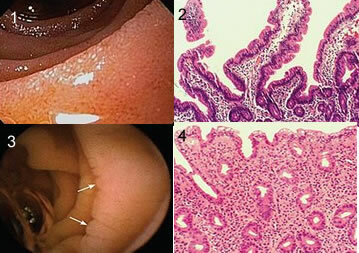O gluten is a protein present in wheat, barley, rye, oats and malt, cereals widely used in the composition of foods, medicines, beverages industrialized products, cosmetics, among others. "Gluten is used to give consistency, elasticity and lightness to the mass of food (in general, cakes, biscuits, breads and pizzas). But it gives little protein gain to the diet," explains nutritionologist Paula Cabral, from the Hagla clinic, in Rio de Janeiro.
Also known as Celiac Sprue, Gluten-Sensitive Enteropathy, Gluten-Induced Enteropathy, Non-Tropical Sprue, and Flour Allergy, celiac diseaseit's an autoimmune diseasecaused by gluten intolerance. People with this disease cannot eat foods that contain gluten, as it attacks and damages the villi of the intestine, impairing the absorption of food.
THE celiac disease can manifest at any age, and in children it can manifest itself soon after the introduction of cereals containing gluten in their diet.

In figures 1 and 2 we can see the image of the intestine of a normal person, while in figures 3 and 4 we can see the image of the intestine of a person with celiac disease
In some people, the celiac disease may be asymptomatic, but in other cases the bearer may have some of the symptoms below:
* Diarrhea with foul, clear, bulky stools, with or without drops of fat or constipation;
* Vomiting;
* Weight loss with ease;
* Weight gain with difficulty;
* Swelling in the legs;
* Anemia;
* Changes in the skin;
* Weakness in the nails;
* Hair loss;
* Decreased fertility;
* Changes in the menstrual cycle;
* Growth retardation in children;
* Signs of malnutrition;
* Flatulence;
* Dermatitis herpetiformis (small itchy sores or blisters on the skin);
* Irritability;
* Abdominal distension (swollen belly);
* Abdominal pain;
* Osteoporosis.

Dermatitis herpetiformis is a variant of celiac disease
The people who are more likely to have celiac disease are those who have diabetes. type 1, autoimmune thyroid disease, Turner syndrome, Williams syndrome, or when there are cases in family.
Because of its many symptoms, celiac disease can take years to be diagnosed. That diagnosis it can be done through stool tests, imaging tests and serological tests. But the most reliable tests are those that detect anti-transglutaminase antibody and anti-endomysial antibody levels. Endoscopy with biopsy to remove tissue samples from the small intestine is also widely used to confirm the disease.
O celiac disease treatment it consists of avoiding, for the rest of your life, the ingestion of foods that contain gluten, such as wheat, oats, rye, barley and malt, breads, cereals, cakes, pizzas, cookies, biscuits, pasta, beer, among many others products. After 1 or 2 weeks of starting the diet, symptoms disappear in most people. Usually 6 to 12 months later, the bowel walls fully recover. In children, growth returns to normal. As this disease has no cure, treatment must be continued for life.
Many people with this disease have to create alternatives to replace the prohibited flour with other foods. With creativity, it is possible to replace it with potato starch, corn flour, corn starch, sweet or sour powder, rice flour or cream, arrowroot flour, cornmeal, etc.
The foods that a person with celiac disease can consume are rice, corn, cassava, cornmeal, starch, oils, margarine, any and all types of fruit, milk, butter, cheese and derivatives (when the celiac does not have diabetes), leaves, carrots, tomatoes, pods, beans, soybeans, chickpeas, peas, lentils, yams, yams, potatoes, cassava, poultry, pork, cattle, goats, giblets, fish and fruits from the sea.
It is very important that people with celiac disease carefully read the labels of the products they will consume, as federal law nº 10.674, of 2003, obliges all food industries to inform on their labels if the product "CONTINS GLUTEN" or "DOES NOT CONTAIN GLUTEN" GLUTEN".
Paula Louredo
Graduated in Biology
Source: Brazil School - https://brasilescola.uol.com.br/doencas/doenca-celiaca.htm

